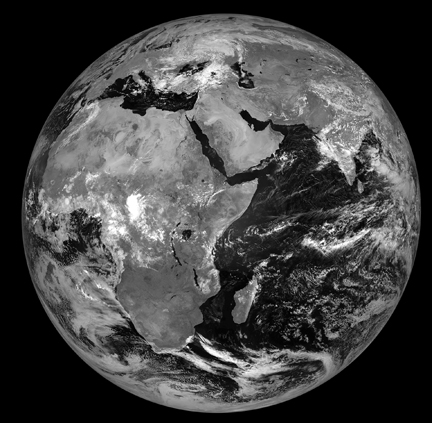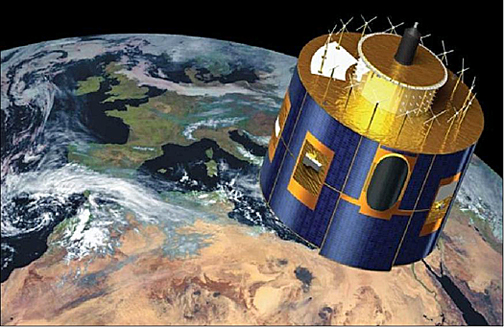
The slot at 41.5 degrees East has heralded the arrival of EUMETSAT's Meteosat-8 satellite, where the spacecraft will be able to better observe the weather and climate over the Indian Ocean.
Meteosat-8 is EUMETSAT’s contribution to the Indian Ocean Data Coverage (IODC) service and will provide this crucial function together with India’s INSAT-3D, at 82 degrees East, China’s FY-2E at 86.5 degrees East and Russia’s Elektro L N2 at 77.8 degrees East in an international, cooperative arrangement.

An image captured by Meteosat-8 at 41.5 degrees East after the satellite's journey to the new slot.
Meteosat-8, the first of EUMETSAT’s Meteosat Second Generation (MSG) meteorological satellites, will replace the soon-to-be-de-orbited Meteosat-7, the last of the 1gen satellites, which had been providing the IODC service but is approaching the end of its nearly 20-year-long lifetime in space.
EUMETSAT’s Head of Strategy, Communication and International Relations Paul Counet said the benefits of the IODC cooperation were wide-reaching, as the provisioingn of better and more frequent observations by Meteosat- 8 from this new position will bring benefits to countries, such as Indian Ocean islands and the east African coast, which experience tropical cyclones. Additionally, this arrangement will allow for better observations of severe weather over EUMETSAT Member States in Central Europe
EUMETSAT’s fleet of MSG satellites fly in a geostationary orbit 36,000 km above the Earth. Their primary instrument is the SEVIRI imager. Meteosat-9, launched in 2005, takes an image of Europe every 5 minutes from its position at 9.5 degrees East. Meteosat-10, launched in 2012, takes an image of the “full-disk” or hemisphere, showing Europe and Africa, every 15 minutes and is stationed at 0 degrees.This imagery provides crucial information for “nowcasting” severe weather events.
Meteosat-8 was, until recently, stationed at 3.5 degrees East, serving as a “hot back-up” for those two satellites. However, in early July, the EUMETSAT Flight Operations team set the spacecraft on an ~80-day drift journey to bring it to its new position.

Artistic rendition of EUMETSAT's Meteosat-8 satellite.
According to EUMETSAT MSG Indian Ocean Data Service Project Manager Flavio Murolo, preparations for this complex project started back in October 2015. The start of the operations of Meteosat-8 will mark an important change for the services provided to users. The drift orbit to bring Meteosat-8 over to 41.5 degrees East was carefully selected to save fuel and to maintain a safe distance from other satellites throughout the relocation. During the drift, a number of tests were carried out on the satellite’s instruments and the complete validation test campaign for the new service will be carried out now that the spacecraft has reached its destination. This will include about two months of parallel operations with Meteosat-7, with data dissemination to users.
He added, "The results of the service validation tests will be reviewed and a formal Operational Readiness Review will be held before Meteosat-8 begins its IODC operational service early next year. The start of the operations of Meteosat-8 over the Indian Ocean region will mark an important change for the services provided to users because it is a transition from the first to the second generation Meteosat satellites. This transition will significantly improve the service, offering a wider suite of products, more observation channels, an enhanced image spatial resolution and more frequent imaging.”
Two maneuvers, conducted 12 hours apart, were required to halt the Meteosat-8 drift.
Murlolo added that the start of the operations of Meteosat-8 will mark an important change for the services provided to users because it is a transition from the first to the second generation Meteosat satellites.

